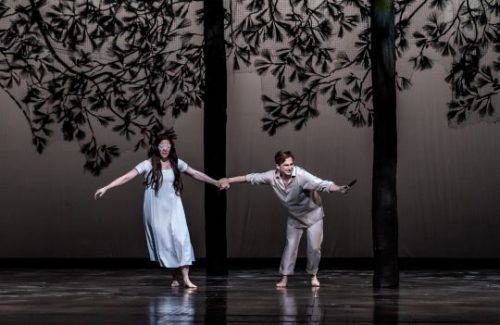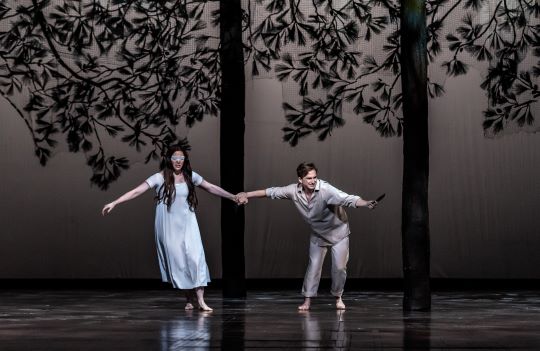 United Kingdom Jette Parker Young Artists Summer Performance: Soloists, Conductors and Orchestra of the Royal Opera House. Royal Opera House, Covent Garden, London, 21.7.2019. (AK)
United Kingdom Jette Parker Young Artists Summer Performance: Soloists, Conductors and Orchestra of the Royal Opera House. Royal Opera House, Covent Garden, London, 21.7.2019. (AK)

Stage director – Noa Naamat
Conductors – James Hendry, Patrick Milne, Thomas Payne and Edmund Whitehead
Singers – Haegee Lee, Jacquelyn Stucker, Yaritza Véliz (sopranos); Aigul Akhmetshina, Hongni Wu (mezzo-sopranos); Patrick Terry (countertenor); Konu Kim, Thando Mjandana (tenors); Germán E. Alcántara, Dominic Sedgwick, Chuma Sijeqa (baritones); Michael Mofidian (bass-baritone)
This showcase for the Jette Parker Young Artists programme presented seven operatic excerpts, four conductors, twelve singers and one stage director. Programming the event (as also previous Jette Parker end-of-year shows) must have been a logistical nightmare: how to showcase all artists at their best (or with their versatility), how to manage scenery changes (with practically no time for changes) and how to present a coherent programme.
The seven excerpts were drawn from much loved popular operas but there did not seem to be any communality between excerpts (unless if love interest served as the common theme). However, the audience seemed happy and appreciative of the format, as indeed operatic excerpts on concert stages are also popular.
It must be hard for singers to fully engage in operatic excerpts, devoid of the prior build-up by librettist and composer. Ironically, to these pairs of ears and eyes, the first item on the programme, the Overture and opening scene from Mozart’s Le nozze di Figaro, was the least satisfactory. I loved the Overture on account of the tempo chosen by conductor Thomas Payne. It was not rushed, as so often it is; every note was crystal clear. Surely Mozart did not write his sparkling notes only for effect, they were meant to be heard (as we heard them on this occasion). I also much appreciated Patrick Milne’s imaginative continuo playing in the recitatives. However I felt uncomfortable with both singers, who I will not name now as neither seemed well cast for their roles (as Susanna and Figaro), or must have been very nervous. Figaro’s top notes were strained, Susanna’s pitching was not up to scrutiny by the highest standard. I missed the chemistry between Figaro and Susanna, furthermore I was slightly irritated by the concept of an over-flirtatious Susanna (with her body-language in contrast with Mozart’s music). I now hasten to add that both singers appeared in later excerpts where both made good impressions on me. And, it so happens, that Figaro was the singer whom I heard and greatly admired as the bass soloist in Bach’s St John Passion three months earlier.
Without doubt, the Act III excerpt from Gluck’s Orfeo ed Euridice was the highlight. A more mature, better acted and better sung performance would be difficult to find anywhere. Neither soprano Jacquelyn Stucker (Euridice) nor countertenor Patrick Terry (Orfeo) gave the impression of young artists at the beginning of their careers. Both owned their parts dramatically as well as musically and they were in tune with each other in every dimension. I felt truly privileged to witness their performance. It is a credit to soprano Yaritza Véliz that she matched her small part of Amore well with the main protagonists.
Hongni Wu’s Mélisande (in the Act III Tower Scene from Pelléas and Mélisande) appeared very strong and manipulative rather than a delicate young woman trapped in an unhappy marriage. Wu’s voice is strong and splendid, ideal for Judith in Bartók’s Bluebeard’s Castle (composed a few years after Debussy completed Pelléas et Mélisande). Indeed, during this excerpt I could not help wondering why Judith turned up in Debussy’s Tower Scene. Dominic Sedgwick, on the other hand, was perfect Pelléas vocally as well as dramatically. Credit is also due to Michael Mofidian’s strong but sensitive Golaud, his lovely bass-baritone voice was well served by the part.
The Act II aria and duet from Samson et Dalila (by Saint-Saëns) was the odd one out of all excerpts (except for the concluding Finale from Act III of Falstaff) as there was no love interest between the protagonists. What united Dalila and the High Priest was their hatred for Samson. Mezzo-soprano Aigul Akhmetshina was wholly credible as the strong seductress; she has the voice, stage presence and passion for her role. Baritone Germán E. Alcántara could have been overshadowed but he held his own as much as the role allows.
I felt somewhat embarrassed by the Act II trio from Rossini’s Il barbiere di Siviglia. The comedy elements seemed overplayed, almost as if in a pantomime. This was unfortunate because tenor Thando Mjandana had only the part of Count Almaviva to show his true worth. He has a splendid voice which he uses well but dramatically he stood no chance with what appears to have been the directorial concept for comedy. Understandably, the orchestral storm (Temporale) introducing the trio evidently served as scene change from Samson et Dalila behind the curtains. However, it gave me a chance to remember the extremely funny yet tasteful choreography to this music in La fille mal gardée by Frederick Ashton.
Soprano Haegee Lee (Gilda) and tenor Konu Kim (The Duke) hugely impressed in an excerpt from Act I of Verdi’s Rigoletto. Both singers are more than ready for any opera stage of any size; they effortlessly filled the auditorium with their astonishing voices and passionate delivery of their roles. However, this was the only excerpt where the scenery did not work. All was played in Gilda’s bedroom, making a nonsense of Ceprano and his friends wondering in and out with Rigoletto before kidnapping Gilda.
The fugal Finale from Act III from Verdi’s Falstaff concluded the programme. It was very funny, very witty and a perfect ending to the show. All twelve singers stood in front of the curtain as their main characters throughout the preceding excerpts, grouped mostly according their roles and wearing their appropriate costumes (as Susanna and Figaro, Orfeo and Euridice, Pelléas and Mélisande, and so on). Their communication with the audience was exemplary and their voices blended into a wonderful choir.
It was no mean task to stage so many different excerpts, but Noa Naamat pulled it off. All four conductors (James Hendry, Patrick Milne, Thomas Payne and Edmund Whitehead) did justice to their allocated music. At no point did I feel that the musical direction was inadequate; on the contrary: I thoroughly enjoyed the musical experience.
Agnes Kory

A not ungenerous review and one with which I largely agree. The bizarre set for the ‘Rigoletto’ extract caused me to reflect that over the years the ROH management – or whoever determines such things – has slowly improved the settings for this event – no longer making do with odd bits of curtain. It has to be said that these young artists are not greenhorns and while not yet starry names, they deserve the best possible environment in which to display their wonderful skills. Just how much value does the ROH place on this event? How much well-targeted publicity does the ROH give it? I was amazed to see significant numbers of empty seats in the Amphitheatre – here is an ‘affordable’ event, an ideal not-too-heavy introduction for young families to the variety and delights of the repertoire. Why was the place not packed out?